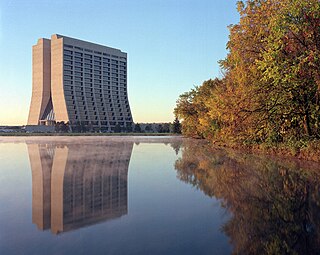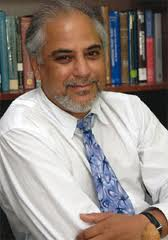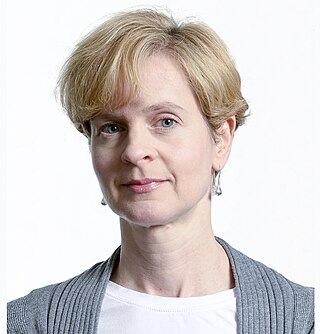
Fermi National Accelerator Laboratory (Fermilab), located in Batavia, Illinois, near Chicago, is a United States Department of Energy national laboratory specializing in high-energy particle physics.

The Tevatron was a circular particle accelerator in the United States, at the Fermi National Accelerator Laboratory, east of Batavia, Illinois, and was the highest energy particle collider until the Large Hadron Collider (LHC) of the European Organization for Nuclear Research (CERN) was built near Geneva, Switzerland. The Tevatron was a synchrotron that accelerated protons and antiprotons in a 6.28 km (3.90 mi) circumference ring to energies of up to 1 TeV, hence its name. The Tevatron was completed in 1983 at a cost of $120 million and significant upgrade investments were made during its active years of 1983–2011.

The Large Hadron Collider (LHC) is the world's largest and highest-energy particle accelerator. It was built by the European Organization for Nuclear Research (CERN) between 1998 and 2008 in collaboration with over 10,000 scientists and hundreds of universities and laboratories across more than 100 countries. It lies in a tunnel 27 kilometres (17 mi) in circumference and as deep as 175 metres (574 ft) beneath the France–Switzerland border near Geneva.

The Underground Area 2 (UA2) experiment was a high-energy physics experiment at the Proton-Antiproton Collider — a modification of the Super Proton Synchrotron (SPS) — at CERN. The experiment ran from 1981 until 1990, and its main objective was to discover the W and Z bosons. UA2, together with the UA1 experiment, succeeded in discovering these particles in 1983, leading to the 1984 Nobel Prize in Physics being awarded to Carlo Rubbia and Simon van der Meer. The UA2 experiment also observed the first evidence for jet production in hadron collisions in 1981, and was involved in the searches of the top quark and of supersymmetric particles. Pierre Darriulat was the spokesperson of UA2 from 1981 to 1986, followed by Luigi Di Lella from 1986 to 1990.

The Collider Detector at Fermilab (CDF) experimental collaboration studies high energy particle collisions from the Tevatron, the world's former highest-energy particle accelerator. The goal is to discover the identity and properties of the particles that make up the universe and to understand the forces and interactions between those particles.
The Very Large Hadron Collider (VLHC) was a proposed future hadron collider planned to be located at Fermilab. The VLHC was planned to be located in a 233 kilometres (145 mi) ring, using the Tevatron as an injector. The VLHC would run in two stages, initially the Stage-1 VLHC would have a collision energy of 40 TeV, and a luminosity of at least 1⋅1034 cm−2⋅s−1 (matching or surpassing the LHC design luminosity, however the LHC has now surpassed this).

The DØ experiment was a worldwide collaboration of scientists conducting research on the fundamental nature of matter. DØ was one of two major experiments located at the Tevatron Collider at Fermilab in Batavia, Illinois. The Tevatron was the world's highest-energy accelerator from 1983 until 2009, when its energy was surpassed by the Large Hadron Collider. The DØ experiment stopped taking data in 2011, when the Tevatron shut down, but data analysis is still ongoing. The DØ detector is preserved in Fermilab's DØ Assembly Building as part of a historical exhibit for public tours.
Stochastic cooling is a form of particle beam cooling. It is used in some particle accelerators and storage rings to control the emittance of the particle beams in the machine. This process uses the electrical signals that the individual charged particles generate in a feedback loop to reduce the tendency of individual particles to move away from the other particles in the beam.
George Randolph Kalbfleisch was an American particle physicist.

Nigel Stuart Lockyer is a British-American experimental particle physicist. He is the current director of the Cornell Laboratory for Accelerator-based ScienceS and Education (CLASSE) as of May 1, 2023. He was the Director of the Fermi National Accelerator Laboratory (Fermilab), in Batavia, Illinois, the leading particle physics laboratory in the United States, from September 2013 to April 2022.

Helen Thom Edwards was an American physicist. She was the lead scientist for the design and construction of the Tevatron at the Fermi National Accelerator Laboratory.

Swapan Chattopadhyay CorrFRSE is an Indian American physicist. Chattopadhyay completed his PhD from the University of California (Berkeley) in 1982.

Young-Kee Kim is a South Korea-born American physicist and Louis Block Distinguished Service Professor of Physics at the University of Chicago. She is chair of the Department of Physics at the university.
Ann Heinson is an American high-energy particle physicist known for her work on single top quark physics. She established and led the DØ Single Top Group which first published experimental observations of the top quark, and in 1997 she co-authored a paper which laid the foundations for further investigation into the top quark.
Alvin Virgil Tollestrup was an American high-energy particle physicist best known for his key roles in the development of the superconducting magnets for Fermilab's Tevatron and the formation of CDF.

The Super Proton–Antiproton Synchrotron was a particle accelerator that operated at CERN from 1981 to 1991. To operate as a proton-antiproton collider the Super Proton Synchrotron (SPS) underwent substantial modifications, altering it from a one beam synchrotron to a two-beam collider. The main experiments at the accelerator were UA1 and UA2, where the W and Z bosons were discovered in 1983. Carlo Rubbia and Simon van der Meer received the 1984 Nobel Prize in Physics for their contributions to the SppS-project, which led to the discovery of the W and Z bosons. Other experiments conducted at the SppS were UA4, UA5 and UA8.

Wendy Taylor is an Experimental Particle Physicist at York University and a former Canada Research Chair. She is the lead for York University's ATLAS experiment group at CERN.
Paul Dutton Grannis is an American physicist.
Nikolitsa (Lia) Merminga is a Greek-born accelerator physicist. In 2022, she was appointed director of Fermi National Accelerator Laboratory, the first woman to hold the position. She has worked at other national laboratories in Canada and the United States.

Bradley Cox is an American physicist, academic and researcher. He is a Professor of Physics and the founder of the High Energy Physics Group at the University of Virginia.












